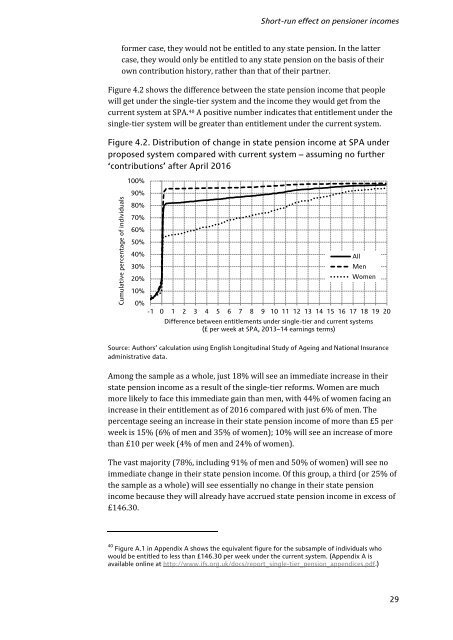A single-tier pension: what does it really mean? - The Institute For ...
A single-tier pension: what does it really mean? - The Institute For ...
A single-tier pension: what does it really mean? - The Institute For ...
Create successful ePaper yourself
Turn your PDF publications into a flip-book with our unique Google optimized e-Paper software.
Short-run effect on <strong>pension</strong>er incomes<br />
former case, they would not be ent<strong>it</strong>led to any state <strong>pension</strong>. In the latter<br />
case, they would only be ent<strong>it</strong>led to any state <strong>pension</strong> on the basis of their<br />
own contribution history, rather than that of their partner.<br />
Figure 4.2 shows the difference between the state <strong>pension</strong> income that people<br />
will get under the <strong>single</strong>-<strong>tier</strong> system and the income they would get from the<br />
current system at SPA. 40 A pos<strong>it</strong>ive number indicates that ent<strong>it</strong>lement under the<br />
<strong>single</strong>-<strong>tier</strong> system will be greater than ent<strong>it</strong>lement under the current system.<br />
Figure 4.2. Distribution of change in state <strong>pension</strong> income at SPA under<br />
proposed system compared w<strong>it</strong>h current system – assuming no further<br />
‘contributions’ after April 2016<br />
Cumulative percentage of individuals<br />
100%<br />
90%<br />
80%<br />
70%<br />
60%<br />
50%<br />
40%<br />
30%<br />
20%<br />
10%<br />
All<br />
Men<br />
Women<br />
0%<br />
-1 0 1 2 3 4 5 6 7 8 9 10 11 12 13 14 15 16 17 18 19 20<br />
Difference between ent<strong>it</strong>lements under <strong>single</strong>-<strong>tier</strong> and current systems<br />
(£ per week at SPA, 2013–14 earnings terms)<br />
Source: Authors’ calculation using English Long<strong>it</strong>udinal Study of Ageing and National Insurance<br />
administrative data.<br />
Among the sample as a whole, just 18% will see an immediate increase in their<br />
state <strong>pension</strong> income as a result of the <strong>single</strong>-<strong>tier</strong> reforms. Women are much<br />
more likely to face this immediate gain than men, w<strong>it</strong>h 44% of women facing an<br />
increase in their ent<strong>it</strong>lement as of 2016 compared w<strong>it</strong>h just 6% of men. <strong>The</strong><br />
percentage seeing an increase in their state <strong>pension</strong> income of more than £5 per<br />
week is 15% (6% of men and 35% of women); 10% will see an increase of more<br />
than £10 per week (4% of men and 24% of women).<br />
<strong>The</strong> vast major<strong>it</strong>y (78%, including 91% of men and 50% of women) will see no<br />
immediate change in their state <strong>pension</strong> income. Of this group, a third (or 25% of<br />
the sample as a whole) will see essentially no change in their state <strong>pension</strong><br />
income because they will already have accrued state <strong>pension</strong> income in excess of<br />
£146.30.<br />
40 Figure A.1 in Appendix A shows the equivalent figure for the subsample of individuals who<br />
would be ent<strong>it</strong>led to less than £146.30 per week under the current system. (Appendix A is<br />
available online at http://www.ifs.org.uk/docs/report_<strong>single</strong>-<strong>tier</strong>_<strong>pension</strong>_appendices.pdf.)<br />
29

















